|
پروفسور محمد
حسین سلطان زاده
استاد دانشگاه علوم پزشکی شهید بهشتی
متخصص کودکان ونوزادان
طی دوره بالینی عفونی از میوکلینیک آمریکا
دبیر برگزاری کنفرانس های ماهیانه گروه اطفال
دانشگاه علوم پزشکی شهید بهشتی
|
SHIRVANI F.
MD MS
KALANTAR MOTAMEDI M. MD
SHEIKHOLESLAM H. MD
RADFAR M. MD
به اتفاق اعضای هیئت علمی گروه کودکان
بیمارستان امام حسین
|
تشخیص
A patient with hydatid cyst
and unusual presenting signs
SHIRVANI F. MD MS
KALANTAR MOTAMEDI M. MD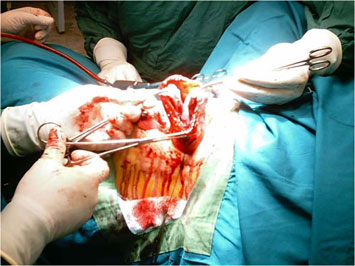
SHEIKHOLESLAM H. MD
RADFAR M. MD
SURGICAL PROCEDURE:
Posterolateral thoracotomy + hydatid cyst evacuation + left lower lobe lobectomy
+ chest tube insertion + pleural space washing
It was
mentioned that after entrance to plueral space , it was ruptured
Pathologic
results
Microscopic: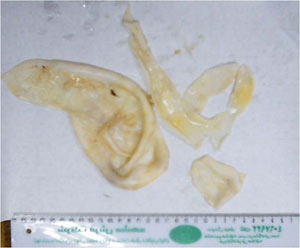
A- sections
show lung tissue with accumulation of fibrinoleukocytic exudate in ,the alveoli
and airways , granulation tissue formation and fibrosis .
B – section
show hydatid cyst wall with daughter cysts , germination layer and laminated
layer.
The patient
received antibiotic by improvement , and after hydatid cyst confirmation
albendazole was started for her preoperatively. the drug continued and follow up
measures was done.
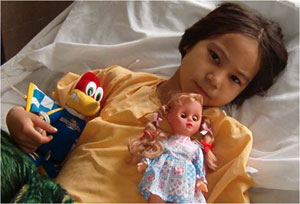
Echinococcus infection is most common in
sheep- and cattle-raising areas and is usually acquired during play with dogs or
through
consumption of food or water contaminated
with dog feces.
adult of Echinococcus granulosis from dog intestine
protoscolices from human hydatid cyst
Occurrence of 60 percent of
hydatid cysts in liver, 30 percent in the lungs, 2.5 percent in the kidney, 2.5
percent in the heart and less than 2 percent in bone, spleen, muscle and brain
have been reported. Other rare sites are orbit, urinary bladder, chest wall,
subcutaneous tissue, parotid, thyroid and retroperitoneal tissues.
Serologic testing is more
specific, but less sensitive, than most imaging modalities.
In patients with lung
cysts, false-negative results occur in up to 50 percent of infections.
Enzyme-linked
immunoelectrotransfer blot (EITB), where available, is the test of choice.
In some studies, it has
greater than 95 percent sensitivity and specificity.
Enzyme-linked immunosorbent
assay (ELISA) has up to 84 percent sensitivity
Weinberg
complement fixation(36-93%sensitivity)
Indirect hemaglutination (66-100%sensitivity)
Where is the
place of FNA
Fine needle
aspiration biopsy (FNAB) was performed in 31 patients with hydatid disease by 15
operators in 41 biopsy events during the period 1983-93. The FNABs were
unintentionally done without prior clinical suspicion of hydatid cysts (HCs) in
18 patients and intentionally (with prior clinical suspicion of HC) in 13
patients for pathologic confirmation required for specific therapy.
only 7 of
31 patients were the specimens diagnostic at the initial interpretation. This
emphasizes the importance of alerting the pathologist about the possibility of
hydatid disease. In 25 of 31 patients (81%) no biopsy reactions occurred.
Suggestions for diagnostic and therapeutic management of patients with HC and
advice to avoid or limit potential complications or spread of disease are given
where a planned biopsy is necessary for appropriate and effective therapy.
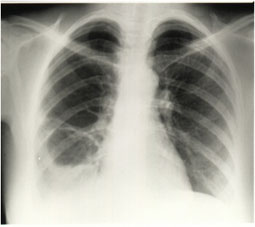 Therapy
for echinococcosis is based on the size, location, and symptomatic complications
of the cysts. Surgery is the treatment of choice; however, removal of the main
cyst mass may not be 100 percent effective because small "daughter" cysts can be
left behind.
Therapy
for echinococcosis is based on the size, location, and symptomatic complications
of the cysts. Surgery is the treatment of choice; however, removal of the main
cyst mass may not be 100 percent effective because small "daughter" cysts can be
left behind.
Mrs Z.N.
35 yr old farmer labourer from the Kwazulu-Natal province. University of
Johannesburg
Echinococcus
multilocularis
CEREBRAL
ALVEOLAR ECHINOCOCCOSIS. REVIEW OF THE LITERATURE AND REPORT OF A CASE, Nezih
OKTAR , Ege University, School of Medicine, Department(s) of Neurosurgery ,
Pathology (ED) and Parasitology ,IZMIR,TURKEY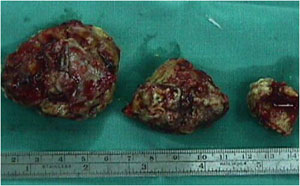
Chemotherapy (e.g., albendazole [Albenza] and mebendazole [Vermox]) is effective
against tapeworm disease, and its use is indicated for the treatment of patients
with inoperable disease or as presurgical and postsurgical treatment to reduce
the risk of recurrence.
Ultrasonographic or computed tomographic (CT)guided fine-needle aspiration of
hydatid cyst contents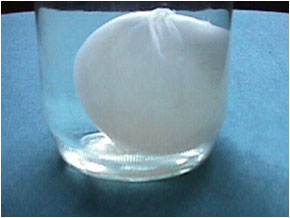 followed by infusion of a killing agent, such as 95 percent ethanol, and
reaspiration, known as PAIR therapy (Puncture, Aspiration, Injection,
Reaspiration), has been used successfully at some centers but carries a risk of
dissemination of infection or anaphylactic reaction caused by cyst puncture and
leakage.
followed by infusion of a killing agent, such as 95 percent ethanol, and
reaspiration, known as PAIR therapy (Puncture, Aspiration, Injection,
Reaspiration), has been used successfully at some centers but carries a risk of
dissemination of infection or anaphylactic reaction caused by cyst puncture and
leakage.
